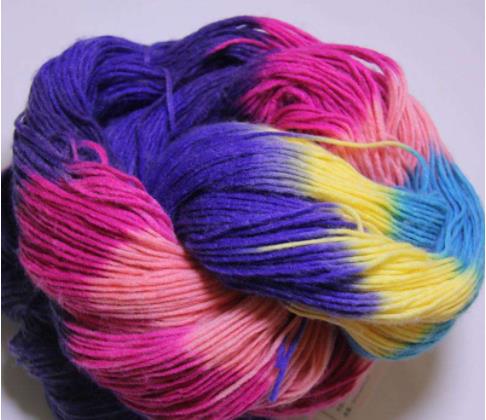Printing operation procedures for fancy yarn and coarse woolen fabric
Water washing and color fixation: Water washing is carried out on a rope washing machine, and the process is as follows:
Printed fabric, wash in cold water (preferably flat), wash in hot water (10 rain), and 6& C soap wash (surfactant, laundry detergent) - wash with warm water - wash with cold water (30 minutes) - dry and color together (30 minutes)
(1) Operational matters:
① First, rinse the floating color with cold water.
② After washing the printed fabric, in order to achieve better color fixation, the drier the fabric, the more advantageous it is.
③ Solid color is carried out in an acidic solution (pH=4): fixing agent 159/l, glacial acetic acid 0.5-19/l, bath ratio 1:30, in a rope machine.
(2) Key technologies:
① Printed fabric should have a lightweight texture, controlled below 4709/m2, and the ground color should be white or light, which is beneficial for summarizing the pattern clearly and displaying the color of the pattern.
② When using acid dyes for printing, in order to promote dye uptake during steaming and avoid or reduce the loss of strength and yellowing of woolen fabrics during steaming, volatile organic acid ammonium salts should be added to the color paste.
③ It is necessary to ensure the maximum color yield on the fabric surface when selecting printing paste. The selection of printing paste, dyes, and additives is crucial. For direct printing of wool/viscose fabrics, a mixture of CMC and cassava starch paste is suitable and cost-effective.

④ The choice of printing net directly affects the coloring rate and even dyeing rate. Practice has shown that it is better to use acid resistant polyester mesh sp30-40 (i.e. 9-11), and if starch slurry is the main material, sp40-45 is better.
⑤ The temperature control of the printing plate has a significant impact on the quality of the finished product. Due to the poor heat resistance of wool, which can withstand dry heat below 70 ° C, in order not to affect the adhesion of the fabric, the plate temperature is controlled between 45-60 ° C. C is more suitable.
⑥ The parameters related to the steamer have a significant impact on the fixation, uniformity, and color brightness of the dye. When using hanging cloth for steaming, it is crucial to control the relative humidity, steam pressure, temperature, and steaming time in the steamer to ensure complete coloring of the printed dye without damaging the strength of the wool fibers. Experiments have shown that in order to ensure coloring, the relative humidity of the wool/viscose fabric during steaming should be greater than 99.7%. If the humidity during steaming is too high, the dye will undergo migration, causing the print to seep open and unclear. If the humidity is too low, the dye will not adhere properly and the color will become dull. The steam pressure is controlled at 78.6-88.4kpa (0.8-0.9kgf/cln2). The temperature should be controlled between 105-110 ℃, and the steaming time should be adjusted according to the arrangement of wool scales to ensure that the acidic dye can fully diffuse into the fibers
It is necessary to increase the steaming time, usually 60 minutes. In order to shorten the time, high boiling point additive Gulixin A (or ethanol) can be added to the color paste to accelerate the diffusion of dyes inside the fibers, reduce the strength damage and yellowing of wool. The dosage of Gulixin A is 2% to 5% of the color paste.
⑦ It is necessary to fully dry the woolen/adhesive fabric before printing. After printing, it is necessary to dry and steam it in a timely manner to avoid moisture during the process, in order to prevent screen printing and water stains.
⑧ When making CMC mixed slurry, the slurry should be mixed at high speed, transparent without white stars, and the pH value should be controlled at around 4.
Article source: Fancy Thread Manufacturer
-
05-27
The reason why fabrics containing spandex are prone to yellowing
Spandex is a commonly used fiber variety in our daily lives, characterized by good elasticity, low fineness, high elastic modulus (cracking elongation can reach 400-800), and low specific gravity. Spa
-
04-24
Colored non dyed nylon with synthetic fiber raw material
The current conventional fiber coloring mostly uses yarn dyeing method, which has long process, high loss, high cost, and the product has color difference and low color wash fastness. Yarn is prone to
-
03-26
What are the characteristics of non dyed spandex?
Non dyed spandex has also been widely used in recent years. Non dyed spandex fiber can be blended with fibers such as nylon, polyester, acrylic, cotton, wool, etc., which can give fabrics excellent el
-
02-24
The influence of yarn structure on fabrics
The basic characteristics of yarn include its appearance and shape, twisting characteristics, fiber transfer and distribution characteristics in the yarn, as well as the surface fuzz and internal loos
